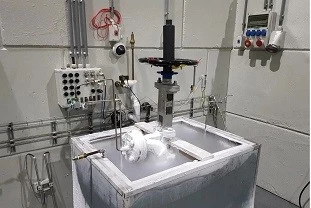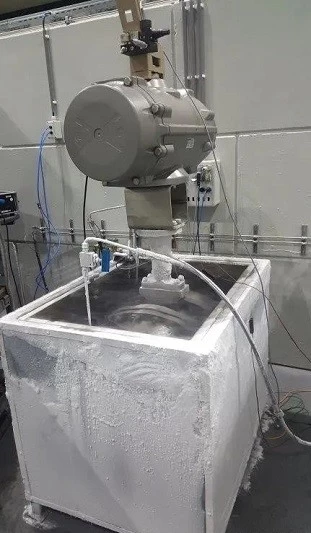Low Temperature Leak Testing
Low Temperature Leak Testing
In recent years, the demand for liquefied natural gas (LNG) has been increasing, leading to an exponential growth in low-temperature valve testing for projects around the world. Despite strict standards in design, engineering, manufacturing, and testing, various products used at low temperatures have failed practicality tests. Conducting low-temperature tests at as low a temperature as possible—down to -253°C—is the answer to this problem.

Liquefied Natural Gas (LNG) is a relatively new product, and for most installed components (such as valves), the applicable standards explain how to design, manufacture, and test these components. However, for many parts, there are no standards available or integrated for use under low-temperature conditions. Given the hazardous nature of LNG, installing components without understanding their functionality can lead to equipment failure, resulting in extremely dangerous situations. Needless to say, reliable installation, installed components, and other equipment are crucial. This necessitates meticulous and extensive low-temperature testing procedures by experts concerning reliability, durability, functionality, and safety.
Hydrogen: The New LNG?
Hydrogen is the smallest molecule and a colorless, odorless gas with steam lighter than air. Could it become a major component of future clean energy systems? Many scientists and industry professionals believe so. It ignites easily and burns with an almost invisible flame. It burns cleanly, producing no carbon dioxide. When hydrogen combines with oxygen in a fuel cell, it generates heat and electricity, with water vapor as the only byproduct. These characteristics bode well for hydrogen's promising future. However, technical challenges in the reliability of industrial components and emissions are concerning. Here too, low-temperature testing plays a significant role.
Low-Temperature Fluids
Examples of low-temperature fluids used by CW includes LNG (liquefied natural gas, at approximately -162°C), liquid oxygen (-183°C), and liquid argon (-186°C). To cool objects, it also uses liquid nitrogen. However, this cooling fluid is not suitable for temperatures as low as -253°C. In this case, liquid helium can be used, as it is suitable for temperatures as low as -269°C.
A Startling Situation
Experience has shown that conducting the aforementioned low-temperature tests is absolutely necessary. Design validation tests for valves often reveal a large number of casting defects, gasket failures, part fractures, leaks, etc. Over 60% of valves fail the test, while the valve data sheets claim that all parts meet PT (Pressure/Temperature) requirements. This is, of course, a startling situation. It illustrates the importance of expert testing. Extensive low-temperature testing procedures are specifically designed to assess and prove the capabilities of valve manufacturers and to demonstrate the functional performance of new design products and components. For valves, low-temperature tests are used to confirm seat sealing, unorganized emission rates, and the operational torque capacity of the valves. During and after the testing procedure, valves undergo a series of mechanical and thermal cycles. These include tests at RT (room temperature), higher design temperature, lower design temperature, followed by another RT test, and finally disassembly, during which any potential damage and wear on the valves are inspected.Forged -196°C cryogenic globe valve if it was made from forged material the material character will fine than casting material.

Costly Confusion
I believe that low-temperature testing should be conducted as early as possible, i.e., in the factory where individual components are manufactured. Typically, individual components for industrial applications undergo pressure testing before being shipped to the customer to check for leaks. The types of tests and methods used are based on a variety of different standards, which often leads to a confusing situation. As a result, the purpose of these tests and the expected outcomes are frequently misunderstood and misused, leading to unnecessary delays, unexpected costs, and, ultimately, hazardous situations that could have been avoided if individual components were subjected to extensive low-temperature testing at an early stage.
Timely Prevention
Low-temperature tests conducted by ITIS show a relatively high failure rate. A closer analysis often reveals that the basic materials, individual components, and/or products applied have never undergone the necessary testing or actual conditions. In a project executed by ITIS, a certain type of valve was used in low-temperature installations. At room temperature, these valves performed perfectly. However, once pressure-tested at low temperatures, all valves failed. They could not work with the original actuator due to increased brittleness and unacceptable tolerance changes. This, of course, could have serious consequences. Operability issues were resolved after the valves were equipped with different seats and a larger actuator. However, this situation could have been entirely avoided with expert low-temperature testing at an early stage under actual conditions.
A Clear Picture
The importance of appropriate and fully customized materials and parts cannot be overstated. What designers and manufacturers need is a clear understanding of the use of one or more products they plan to manufacture and the conditions they will ultimately have to perform under. For example, many PTFE manufacturers claim that their working temperature can be as low as -200°C (-328°F) with little increase in brittleness. They also claim that the product maintains high strength, toughness, and self-lubricating properties at temperatures below -268°C (-450°F). However, tests conducted at ITIS testing facilities show that the strength and flexibility of the product cannot be guaranteed below -200°C. For instance, if used for seat manufacturing, it may prove unsuitable in certain cases, leading to serious problems. This once again proves that early low-temperature testing is worthwhile.
Unorganized Emission Testing
Unorganized emissions are the release of gas or vapor from pressurized equipment due to leaks and other unexpected or irregular gas emissions (mainly from industrial activities). In addition to the economic cost of lost commodities, unorganized emissions also cause air pollution, and some vapors pose potential hazards to human health and safety. Therefore, industrial components must comply with many international standards and directives regarding the emission of hazardous substances, such as ISO 15848-1 (International Standard), TA Luft (applicable to Germany), and API (USA). Compliance is achieved through leak testing (preferably at the earliest stage possible). Even new complete installations can be tested for leaks before startup, after overhaul, or during shutdown periods. For example, in the form of unorganized emission testing. FET testing is a highly accurate leak detection method used to locate and quantify leaks in various industries and applications.
Expert Tips to Prevent Failures at Low Temperatures
1.Check that all information about the materials you intend to use for your product is available. Sometimes, valve seats and seals are selected based on the PT (Pressure/Temperature) diagrams provided by manufacturers. However, the performance of the product may differ when used at lower temperatures or pressure rates.
2.Ensure that your product is free of dust and/or oil and is completely dry before installation or testing. In many cases, liquids such as water with corrosion inhibitors are used during hydrostatic testing. At lower temperatures, this can lead to failures.
3.Use seals and gaskets suitable for the fluid involved, in conjunction with the specific temperature conditions of the seals and gaskets.
4.Studies show that products have never been tested under the conditions mentioned in the product data sheets (minimum/maximum temperature) or exposed to those conditions.
5.Obtain necessary data on the integrity of the products you will use and their applications. Test the product at least under actual conditions (temperature, pressure, operating cycles, etc.).
6.Some materials are best cooled to a specific minimum temperature rate/duration to prevent failures. Excessive temperature changes can cause materials to contract or crack.
 +86 512 68781993
+86 512 68781993 


















